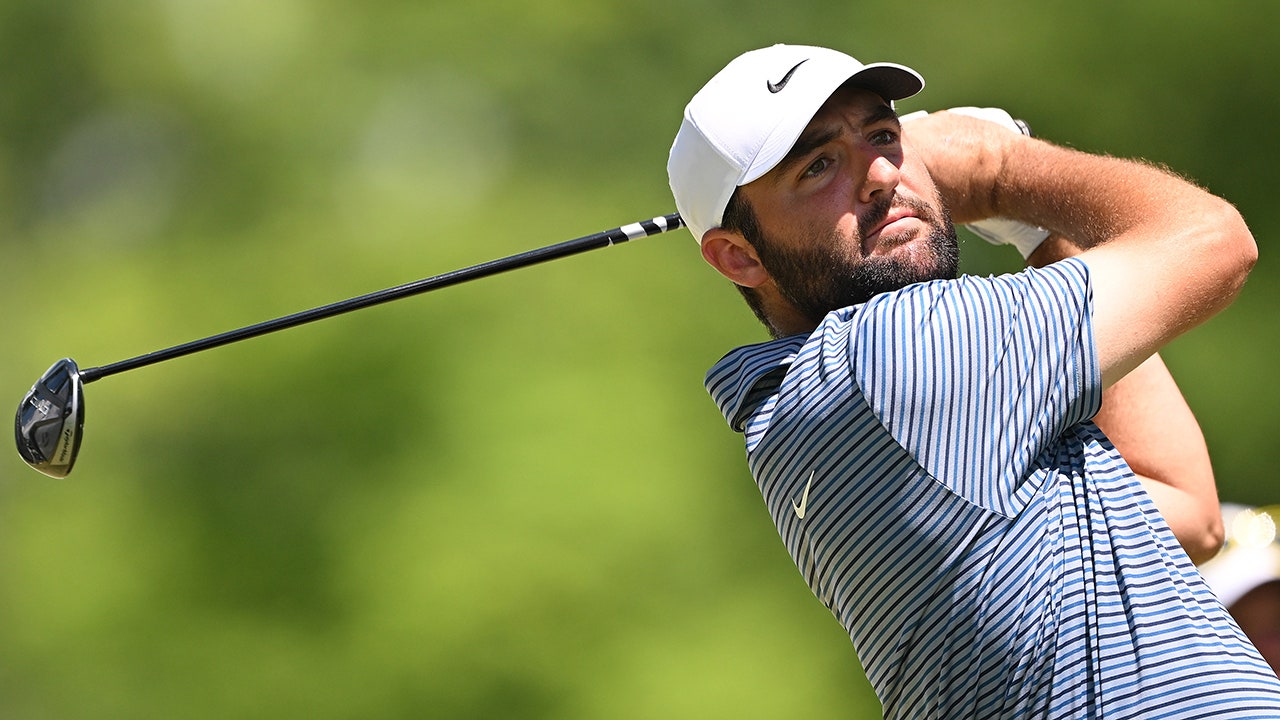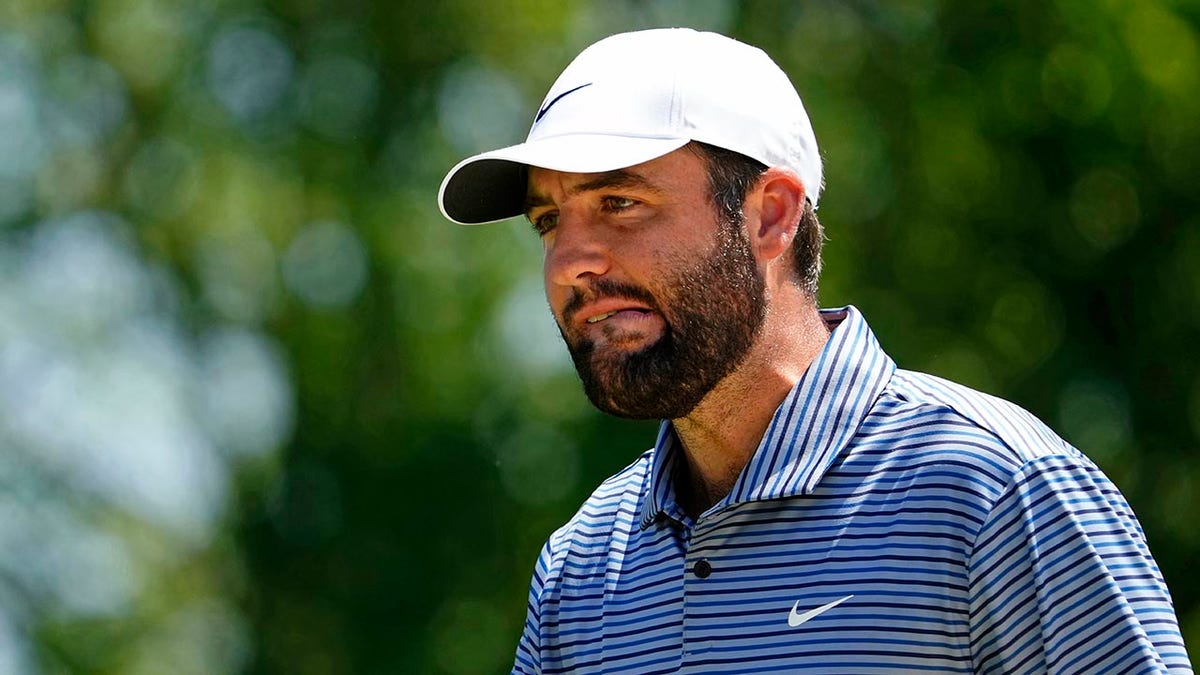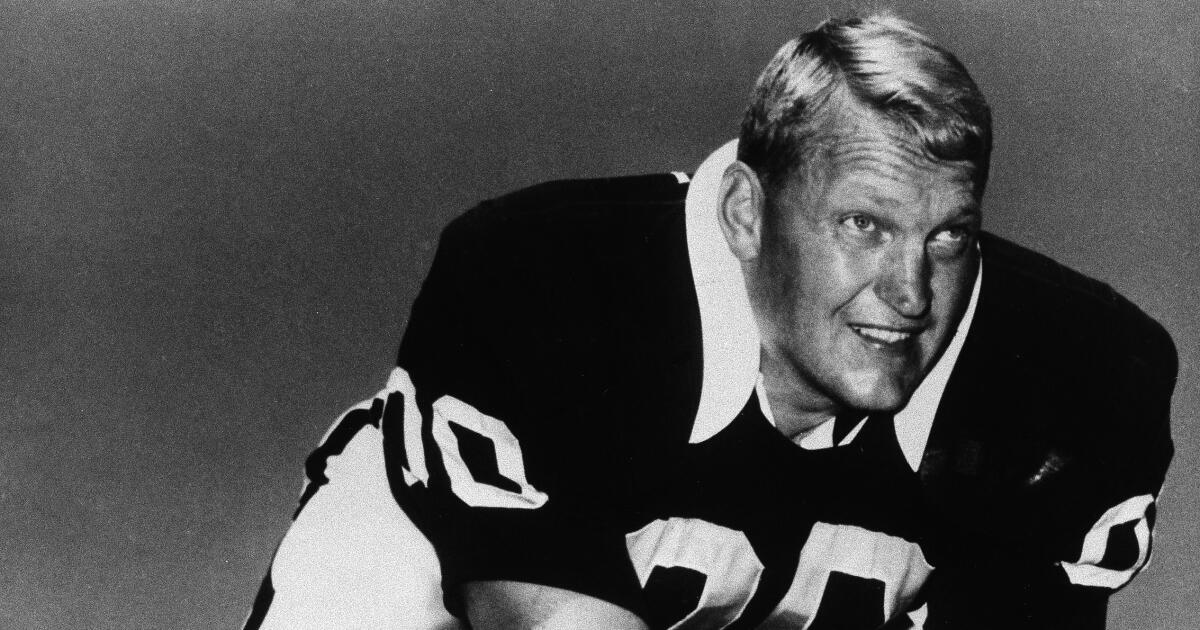Sports
Lakers eliminated by Nuggets in Game 5 on Jamal Murray's final shot

Did LeBron James play his last game for the Lakers?
The Lakers’ season ended Monday night after a 108-106 loss to the Denver Nuggets at Ball Arena in Game 5 of their Western Conference first-round playoff series, at which point nothing bound James to the team.
James, 39, can decline his $50.4-million option for next season.
The choice will say more about the priorities of the 39-year-old James than the state of the Lakers.
In James’ six seasons with the Lakers, they have been eliminated in the first round of the playoffs twice and not even reached them two other times.
The franchise is now four seasons removed from the championship it won in the NBA bubble.
Lakers forward Anthony Davis, right, looks to pass the ball after spinning around Nuggets center Nikola Jokic during Game 5 in Denver.
(David Zalubowski / Associated Press)
The Lakers might be the Lakers in name, but they’re not the Lakers in performance.
Their Game 5 loss was the result of the kind of shot Lakers players used to make in their glory years, as Nuggets guard Jamal Murray sank a 14-foot jumper over Austin Reaves with four seconds left.
The fact the Lakers were in position to return the series to Los Angeles for a sixth game was a surprise, considering what happened to Anthony Davis earlier in the game.
About a minute into the second half, with the Lakers leading by six points, Davis bumped into Michael Porter Jr. as he ran by him. Davis crumbled to the court clutching his left shoulder.
Davis remained in the game but was never the same.
A couple of minutes later, Davis reached with his left hand to contest a jumper by Murray. The shot went in. Davis winced in pain.
With about three minutes left in the third quarter, Davis departed the Lakers’ bench area and headed toward the locker room. When the quarter ended, the Lakers were down 81-79.
Davis returned to the court for the fourth quarter.
A compromised Davis finished with 17 points and 15 rebounds. Each of the Lakers’ starters scored 14 or more points, led by James with 30. Austin Reaves scored 19, Rui Hachimura had 15 and D’Angelo Russell 14.
“I couldn’t be more proud of our crew despite everything that happened,” Lakers coach Darvin Ham said. “Obviously, the series didn’t go in our favor, didn’t start the way we wanted it to, but to win that one at home, fight tooth and nail today to get this one, our guys showed a lot of guts and a lot of character and that resilience to continue to fight.”
There were early indications this game wouldn’t be like the last one — or, for that matter, any of the four before it.
For the first time in the series, the Nuggets led after the first quarter. Murray, who was listed as questionable for the game because of a left calf strain, scored 12 points in the period to give his team a 28-24 lead.
Playing with a dark blue wrap on his injured leg, Murray made four of nine shots in the opening quarter, including three of six from three-point range. Murray made only 38% of his shots over the previous four games.
The Lakers went into halftime with a 53-50 edge, however, courtesy of James and Davis. James registered 10 points and seven assists before the break; Davis had 16 points and nine rebounds.
Murray finished with a game-high 32 points.
In retrospect, the series was a microcosm of the Lakers’ season — hopelessness followed by more hopelessness followed by a smidge of optimism that was ultimately extinguished by the reaffirmation of the previously mentioned hopelessness.
Last season, the Lakers made up for their underwhelming regular season by reaching the Western Conference finals, which convinced their braintrust to retain the nucleus of their roster. This season, there was no such miracle to cover up their shortcomings.

Sports
McIndoe: It's time for the NHL to stop interference and offside reviews

The symmetry was almost perfect.
In the history of the NHL’s foray into the world of replay review, there are two moments that stand out as crucial landmarks, the key signposts that pointed us toward where we wound up. The most recent came in 2013, when Colorado center Matt Duchene scored a goal despite being roughly a mile offside.
The play is, to this day, widely misunderstood. The linesman didn’t somehow miss the fact that Duchene was offside; rather, he thought that the Nashville Predators had directed the puck back into their own zone, which would negate an offside call. But the optics were terrible. Everything about the play looked wrong, up to and including Duchene’s muted celebration. He knew he’d gotten away with one, as did everyone watching. And, eventually, the confusion and frustration of such an obvious missed call coalesced around a seemingly easy solution: Why don’t we have replay review for these plays?
And now we do, and it’s awful, but hold that thought. Because for the other key moment, we have to go back even further. Now it’s the 1999 Stanley Cup Final, and we’re in triple overtime of Game 6. With the Buffalo Sabres fighting to extend the series, the Dallas Stars’ Brett Hull collects a rebound and scores the Cup winner.
Hull’s skate is clearly in the crease, and for just about all of the previous four years, that had meant an easy no-goal call, thanks to a cut-and-dried rule that we all hated. But this time, there’s no pause for a review, no announcement from the officials. Hull scores, the celebration is on, and next thing you know, Gary Bettman is out there with the Stanley Cup while fans around the world watched replays and tried to figure out how a goal we were sure had been waved off 100 times before was now allowed to count.
This play is misunderstood, too, although most of that falls on the NHL. There’s an interpretation of the 1990s crease rule that allows for players to be in the crease if they have possession of the puck, which Hull kind of, sort of does. There was reportedly a memo about exactly this sort of play that had gone out a few weeks before Hull’s goal, although nobody thought to mention it to the fans. But none of that really matters, because the apparent lack of any formal review would be the last straw for a rule that clearly wasn’t working. The NHL ditched the crease rule that summer, one of the very few examples from Bettman’s era of the league admitting a mistake and taking action to correct it.
The symmetry is almost perfect. A little too perfect, really. Because now, all these years later, we’ve got another replay debate involving the Dallas Stars. Once again, it’s about a player in the crease. Once again, it’s from Game 6, in overtime, of a series the Stars are trying to close out, just like that infamous 1999 goal.
And who’s in the middle of it all? Our old friend Matt Duchene.
Here’s the play in question, if you somehow missed it. It’s Friday night, or early Saturday morning depending on where you are. We’re midway through the first overtime, and Mason Marchment appears to score what would be the series winner. But the referee on the ice waves it off immediately and emphatically, and (to his credit) even explains why to the audience: Contact in the blue paint, no goal.
And then we all watched the replay and … oof.
That’s Duchene in front, number 95. He skates right up to the Colorado crease, but stops just short, or maybe not. He’s screening Colorado goaltender Alexandar Georgiev and then there’s some contact with defenseman Cale Makar, pushing Duchene a little closer. At some point, there’s very light contact with Georgiev, who ends up out of position and unable to stop Marchment’s incoming shot.
Is that goalie interference? You know the drill by now — nobody knows, none of us understand the rule, they’re flipping coins, etc. You also know that it’s not true, and that the rulebook isn’t all that complicated, and that with just a few minutes of actually learning the rule, it’s possible to get about 90 percent of these, but at this point, people seem to love putting on a show of feigned ignorance.
In this case, it all comes down to whether Duchene is in the crease or not, and it’s close. Based on the replays we see, he doesn’t seem to be. Maybe he is once Makar arrives to make contact, but that would be a case of the defending team forcing the attacking team into the crease. To my eyes, this goal looks like it should count, although there’s a case for both sides. But the call on the ice is no goal, and the league has been deferring to that with what seems like increasing frequency this season, which is what the rulebook says we should do. So we’re in that dreaded 10 percent, where we’re not really sure. And there’s a series on the line.
Eventually, the word comes down. The call on the ice stands. No goal. And it’s fair to say that most fans watching didn’t seem to agree. One of the things that happens when you go around like some sort of self-anointed expert writing guides to controversial rules is that fans like to send you their thoughts when those calls happen. My unscientific survey says that you think the league got the call wrong, in very large (although certainly not unanimous) numbers. The vast majority of you thought the Stars got robbed.
The best thing you can say about that call is that it didn’t end up mattering, because Duchene himself scored in double overtime to end the series. Puck don’t lie, and all that. That was a tough result for the Avalanche, but probably a lucky one for the league, which ended up with a controversial no-goal, but not a no-goal that will live in infamy.
No harm done, right? Well … maybe.
In the big picture, the right team won and we can all move on. But we shouldn’t do that. Because this is pretty clearly the game giving us a message. Come on, it’s Matt Duchene, in Game 6 overtime of a Dallas Stars playoff clincher? The hockey gods couldn’t be any more obvious here. They’re practically putting a big flashing neon sign on the ice, and that sign says “Fix replay.”
So let’s do that. Let’s fix the replay system, in the best and simplest way that we could: By getting rid of it.
That’s it. That’s the answer, folks. Yes, there are other ways we could do this, ways that would be vast improvements on the current mess of a system. I’ve pitched a few of those ideas myself. But why settle for being a little bit better when we can fix this once and for all?
Dump it. Trash it. No more replay review, for interference or offside. It’s time to do what the league did in 1999, and read the writing on the wall. This time, we’ve even got a chance to do it before the inevitable disaster that will ruin a Stanley Cup Final.
The goaltender interference rule isn’t as complicated as you think, but it’s a terrible fit for replay review because almost all of the various contingencies are subjective. Was contact incidental? Did it prevent the goalie from playing his position? Did he have time to recover and reset? All of that falls into a gray area of an official’s opinion. Yet we still stop the game for extended reviews under the pretext of “getting it right,” searching and scanning for the one freeze frame that will get everyone to agree. We never, ever find it. Instead, we end up with a decision that nobody agrees on. One fan base thinks it’s obvious in their direction, the other thinks it’s obvious for them, and everyone else shrugs and isn’t completely sure, no matter how many angles we get.
If your system is in place because you have to get it right and nobody thinks you do, then your system is broken. Get rid of it.
Then there’s offside, a play that’s at least theoretically objective. You’re over the line, or you’re not, and unless it’s one of those outlier plays where we have to argue about possession, we should be able to find that one freeze frame that lets us all agree. And we do! Occasionally. But most times, we don’t. The angle isn’t quite right, or the footage isn’t quite clear enough, or it ends up being too close to call. And through it all, there’s a good chance that the entry we’re reviewing happened well before the goal, maybe with a few changes of possessions in between. What are we doing here?
We put the system in place to catch a repeat of that initial Duchene miss, and over a decade later, we haven’t had a single one. Instead, we’ve got video coaches watching every zone entry, looking for get-out-of-jail-free cards. We’ve got linesmen who are pretty clearly letting close plays go, because they know that replay is lurking. We’ve had guys changing lines, completely out of the play, getting caught on technicalities that decide a Game 7.
And through it all, a generation of fans have been taught not to get too excited about a goal, because you never know when that random replay is going to take it off the board. A league starved for offense has taught its audience that some goals have to be stricken from the record, just because. Every exciting moment is followed by a shot of a listless coach staring down at an iPad. Countless games ground to a halt. Excitement sapped out of buildings.
All in the name of just getting it right, which nobody thinks we’re actually doing.
Everybody’s mad all the time. Literally every fan base thinks the Toronto situation room is biased against them personally. Everyone pretends they don’t understand interference. Nobody can squint hard enough to know which blue-line pixel we’re supposed to be fixating on. We’re all yelling at each other, constantly. The league’s own broadcasters are accusing the refs of betting on games. It’s all become a contest to see who can be the angriest, all the time, at the loudest volume. It’s exhausting.
Nobody thinks this is working. But we’re convinced we have to keep doing it, because what if we go back and something gets missed?
Well, what if it did? You old-timer fans out there: How many missed offside calls do you remember being mad about, back in the day? Sure, Leon Stickle, which was in 1980. How many others? What about goalie interference? Was that a play you spent a lot of time thinking about back in the pre-replay days?
Not really. Instead, we all understood that sometimes there would be a close call, and sometimes it would go against your team, and that was life as a sports fan. That’s not to say we didn’t get mad, or complain, or spend roughly 30 years crying about it. But we understood that it was how sports worked, and we didn’t expect the entire game to grind to a halt a few times a night so that we could find one frame of footage to obsess over, all while getting most of the calls right but some of them wrong, because that’s sports.
I’m not saying we ditch replay entirely. There are elements of the game in which it works perfectly, exactly the way it’s intended. Keep it for figuring out if time had expired before a goal, absolutely. Use it for determining if a puck crossed the line, as long as you understand that sometimes you just won’t be sure. Keep using it for kicked-in goals, if you insist, although that won’t work all the time, either.
But offside reviews that come down to a millimeter? No. And goalie interference calls that are almost entirely subjective? Absolutely not. Because right now, we’re not getting it right, at least not the way we were promised. We’re arguing more, not less. And we’re not making anyone feel better about NHL officiating. We don’t need to do this anymore.
I know it. You know it. And the hockey gods know it, too, which is why they hit us between the eyes with a decidedly over-the-top message on Friday night. This time, they were even kind enough to do it in a way that didn’t cost a team a series or create a controversy that we’ll remember years from now. Next time, we might not be so lucky.
Duchene got us into this mess. Maybe he can be the one to save us, too. Scrap replay review, accept that there will be calls that don’t go your team’s way, and live with it. As we found out in 1999, that option isn’t perfect, but it’s a lot better than the inevitable alternative.
(Photo of referee Dan O’Rouke: Claus Andersen / Getty Images)
Sports
Scottie Scheffler's arraignment date for arrest at PGA Championship delayed

Scottie Scheffler’s arraignment following his arrest prior to the second round of the PGA Championship has been pushed from Tuesday to June 3.
Steve Romines, Scheffler’s attorney, told ESPN that his client will be pleading not guilty to the multiple charges that stemmed from what the golfer called a “big misunderstanding” while trying to enter Valhalla Golf Club prior to his round.
A conflict in Romines’ schedule is the reason behind the delay, though Scheffler was never attending the arraignment in Louisville to begin with.
Scottie Scheffler tees off on the eighth hole during the third round of the PGA Championship at Valhalla Golf Club on May 18, 2024, in Louisville, Kentucky. (Clare Grant-USA Today Sports)
It was quite the chaotic week at the season’s second major, as Scheffler was arrested outside Valhalla early Friday morning for not following police orders. A 69-year-old man, John Mills, was pronounced dead at the scene of police activity after being struck by a shuttle bus. Mills was working as a vendor at Valhalla for the tournament.
Scheffler was trying to get into the golf course when the incident occurred, and Detective Bryan Gillis allegedly tried to stop him from proceeding. The officer says Scheffler accelerated his SUV, and he attached himself to it, which led to him being dragged and causing injuries.
KENTUCKY INMATE REVEALS WHAT SCOTTIE SCHEFFLER THOUGHT OF SHOCKING ARREST
Scheffler was immediately asked to exit his vehicle and put in handcuffs. He was then taken to the police station and booked. Wearing an orange jumpsuit, Scheffler was charged with second-degree assault of a police officer, third-degree criminal mischief, reckless driving and disregarding signals from an officer directing traffic.
Scheffler ended up making it back in time for his second round. He finished tied-eighth at 13-under, as Xander Schauffele’s birdie on the 18th hole Sunday gave him his first career major victory.

Scottie Scheffler walks off the first green during the final round of the PGA Championship at Valhalla Golf Club on May 19, 2024. (Adam Cairns-USA Today Sports)
Speaking after his tournament was finished, Scheffler said he was “fairly tired,” though he was “proud of how he fought” during the week. He previously said it was an obvious first for him that he was stretching in jail, going through his normal routine ahead of the second round.
Now, the arraignment may not come based on a report from No Laying Up, which stated Sunday that a source “familiar with” the Jefferson County Prosecutors Office’s thinking said they were planning to drop charges “as of now.” That could always change, but it may come to fruition.
A Louisville Metro Police Department spokesman also told ESPN that Gillis failed to activate his bodycam video during the incident involving Scheffler.

Scottie Scheffler plays his shot from the 12th tee during the final round of the PGA Championship on May 19, 2024. (Ross Kinnaird/Getty Images)
Scheffler is scheduled to participate in the Charles Schwab Challenge this week at Colonial Golf Club in Harrisburg, Penn.
Follow Fox News Digital’s sports coverage on X, and subscribe to the Fox News Sports Huddle newsletter.
Sports
Jim Otto, Hall of Fame Raiders center who never missed a game, dies at 86

Jim Otto, the Hall of Fame center who never missed a game during his 15 seasons with the Raiders in the 1960s and 1970s, has died at 86, the team announced Sunday night. No cause of death was given.
“The Raiders Family is in deep mourning following the passing of Jim Otto,” the Las Vegas Raiders said in a statement posted on X (formerly Twitter). “The Original Raider. The personification of consistency, Jim’s influence on the American Football League and professional football as a whole cannot be overstated. His leadership and tenacity were a hallmark of the dominant Raider teams of the 1960s and 70s.”
Jim Otto poses with his bust after being enshrined in the Pro Football Hall of Fame on Aug. 2, 1980, in Canton, Ohio.
(Associated Press)
Otto was enshrined into the Pro Football Hall of Fame in 1980, his first year of eligibility, with a speech by late Raiders owner Al Davis.
“For more than a decade he was the standard of excellence by which centers were judged in professional football,” Davis said of Otto during his speech. “He was the most honored offense lineman in the history of professional football. But statistics are just a measure of accomplishment, not really the measure of a man. If it is true that great men inspire in others the will to be great, that alone qualifies Jim to be a great man.”
On Sunday night, the Raiders tweeted a video of current owner Mark Davis lighting his father’s memorial torch at Allegiant Stadium in Otto’s honor.
An undrafted rookie out of the University of Miami in 1960, Otto was the first person to snap the ball for the Oakland Raiders, a first-year team in the new American Football League that competed with the NFL until the leagues merged in 1970. He was a 10-time All-AFL selection, making him the only center to earn that honor, and was named to 12 Pro Bowls before retiring after the 1974 season.
He is one of three players to have played in every game during the 10-season span of the AFL. The others are Gino Capelletti of the Boston Patriots and George Blanda of the Houston Oilers and Raiders.
Otto was nicknamed “Double 0,” after his jersey number 00 — a nod to the pronunciation of his last name, “Aught-oh”) — which he wore every season except his first, when he was issued No. 50.
He also earned the moniker “Mr. Raider” during a career in which he played 210 straight regular-season games and 223 straight games counting playoffs. He played through numerous ailments and medical conditions, having undergone nine knee surgeries during his career.
“There’s something inside of you that says, ‘I want to go out there and prove my worth,’ ” Otto told Bleacher Report in 2009. “Most of the time you’re going to get injuries. That’s the life you choose. Some people need a challenge in life and they play hockey or rugby. Football was the way I could prove myself.”
In a 2012 interview with PBS’ “Frontline,” Otto stated that he had been operated on 74 times in his lifetime. He had multiple joint replacements, as well as procedures to help deal with arthritis and debilitating neck and back issues. After two major infections, Otto had his right leg amputated above the knee in 2007.

Hall of Famer Jim Otto smiles before an NFL football game between the Raiders and the Pittsburgh Steelers on Sept. 24 in Las Vegas.
(Mark J. Terrill / Associated Press)
Otto also told “Frontline” he had suffered more than 20 concussions.
“I think that everything that has caused my body to be a problem has been from football, you know?” he said.
In 2002, Otto revealed he was battling advanced prostate cancer.
“A couple years ago, with readings like mine, you would have had six months to live,” Otto told The Times’ Sam Farmer at the time. “[But] we’ve got a way of fighting it, and we’re going to kick its butt.”
Four years later, after finishing his treatment at the UC Davis Cancer Center, Otto agreed to chair the center’s $35-million capital and endowment initiative.
“I would just love to see more people being saved and being cured from cancer,” Otto said at the time. “That’s why I’m doing this. You don’t want anyone else to have to go through the agony that comes along with a cancer diagnosis and cancer treatment. Especially kids. I’ve visited the children in the pediatric ward and, well, that eats your heart out. Something has to be done.”
Otto was born Jan. 5, 1938, in Wausau, Wis. His family lived in poverty, at one point having to move into a chicken coop for shelter. He played football at Wausau High School and was a center and linebacker at Miami before helping establish the Raiders as a force in the AFL and later the NFL. They won their division in seven of Otto’s final eight seasons, winning the AFL title following the 1967 season before losing to the Green Bay Packers in Super Bowl II.
“Rip Jim Otto,” Raiders star defensive end Maxx Crosby tweeted Sunday night. “Absolute Legend & Incredible Person.”
In all eight of those seasons, Otto started every game alongside fellow future Hall of Fame offensive lineman Gene Upshaw.
“Jim Otto personified the aura and mystique of the Raiders,” Pro Football Hall of Fame President Jim Porter said in a statement. “… The Pro Football Hall of Fame will guard his legacy with the same diligence and tenacity that he guarded his teammates.”
Otto kept close ties with the Raiders organization following his retirement as a player. He played a key role in negotiating the team’s move back to Oakland from Los Angeles before the 1995 season (the Raiders moved to Las Vegas in 2020) and most recently was the club’s director of special projects.
In January, Otto visited the locker room following a win over the Denver Broncos in the final game of the season.
“The @Raiders lost a legend in HOF Jim Otto,” Rich Gannon, who was the Raiders quarterback from 1999-2004, wrote Monday on X. “I will never forget the first time I met him in the equipment room in Alameda. His stories were legendary but his kindness and humility is what I will remember the most. God Bless brother!”
He is survived by his wife, Sally, son Jim and daughter-in-law Leah, and 14 grandchildren — Alice, Sarah, Amy, Amanda, Josiah, Hannah, Jeremiah, Isaiah, Jennifer, Avery, Noah, Aiden, Roman and Ellie.
-

 News1 week ago
News1 week agoSkeletal remains found almost 40 years ago identified as woman who disappeared in 1968
-

 World1 week ago
World1 week agoIndia Lok Sabha election 2024 Phase 4: Who votes and what’s at stake?
-

 Movie Reviews1 week ago
Movie Reviews1 week ago“Kingdom of the Planet of the Apes”: Disney's New Kingdom is Far From Magical (Movie Review)
-

 World1 week ago
World1 week agoUkraine’s military chief admits ‘difficult situation’ in Kharkiv region
-

 World1 week ago
World1 week agoBorrell: Spain, Ireland and others could recognise Palestine on 21 May
-

 Politics1 week ago
Politics1 week agoTales from the trail: The blue states Trump eyes to turn red in November
-

 World1 week ago
World1 week agoCatalans vote in crucial regional election for the separatist movement
-

 Politics1 week ago
Politics1 week agoNorth Dakota gov, former presidential candidate Doug Burgum front and center at Trump New Jersey rally














